MAPPING PROMPTS TO NLP MODELS FOR UI GENERATIONS
By Oluwatomiwa Ajiferuke
Supervised by
Dr. Ivan Conde Rodriguez,
Dr. Arya Basu,
Emerging Analytics Center,
University of Arkansas at Little Rock
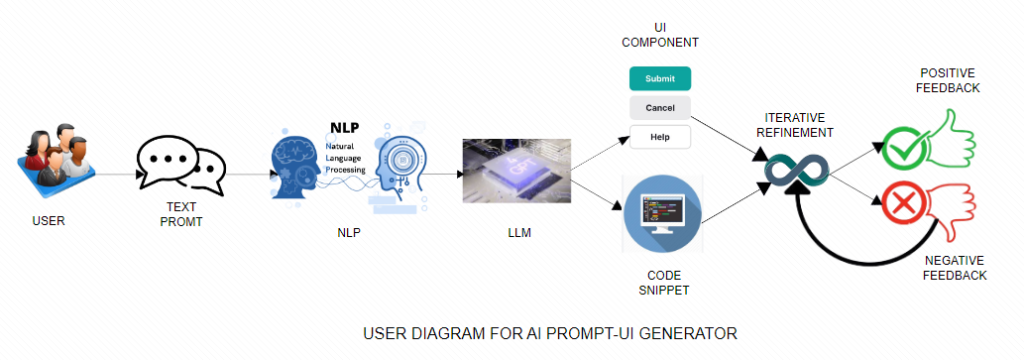

Leading the charge in human-computer interaction research, the Emerging Analytics Center (EAC) at the University of Arkansas at Little Rock has introduced the AI Prompt-UI Generator. This innovative project is set to transform the field of user interface (UI) development by leveraging artificial intelligence. user interface (UI) serves as the essential bridge between humans and computers, websites, or applications (Jitnupong & Jirachiefpattana, 2018). It includes both tangible elements like input devices and communicative aspects of output, facilitating seamless interaction (Marcus, 2002). Key components of UI include recognizable symbols and concepts, intuitive navigation, user interaction patterns, and visual aesthetics. An effective UI within an information system aims to deliver a user-friendly experience that maximizes usability with minimal effort (IDT, 2022). While UI design focuses on the aesthetic and interactive aspects of a product, UI development involves translating these designs into functional interfaces through coding (OpenAI, 2023). This process ensures that the UI not only looks appealing but also functions smoothly, meeting the needs and expectations of its users.
The pivotal aspect of this project lies in effectively mapping natural language prompts, specifically text prompts, to NLP (Natural Language Processing) models with the help of generative AI and other integrated technologies such as UI frameworks, relational database management system, system programming language, vector similarity search engine to carryout UI development. The AI Prompt-UI Generator is designed to generate UI elements and components with specific properties and design principles.
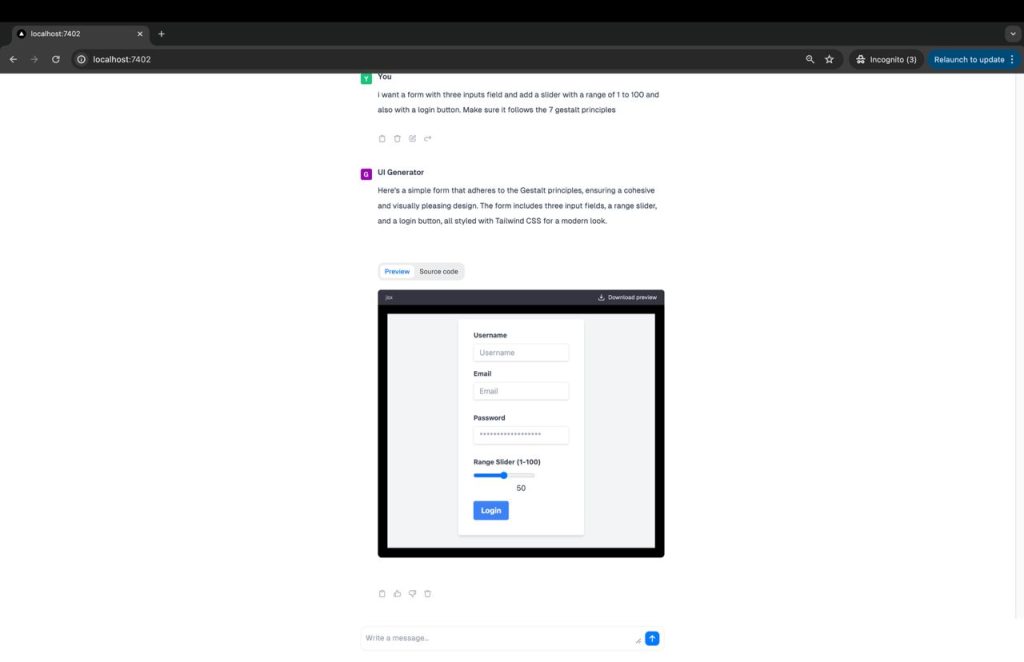
Natural Language Processing (NLP) is a branch of artificial intelligence and linguistics that empowers computers to understand, interpret, and generate human language. By combining computational linguistics, statistical modeling, machine learning, and deep learning, NLP facilitates the recognition, comprehension, and production of text and speech (Holdsworth, 2024), while natural language prompts are instructions or queries written in everyday human language that are used to interact with or elicit responses from AI models, or software applications. They are designed to be easily understood and can be as simple as asking a question or making a request (Strobelt et al., 2022).
At the core of the AI Prompt-UI Generator lies the integration of OpenAI’s advanced GPT-4 API model, a powerful large language model (LLM) meticulously trained on vast text and code datasets. Built on a transformer architecture, this model excels in processing and generating text (Raiaan et al., 2024). As an LLM, GPT-4 is capable of performing a wide array of natural language processing (NLP) tasks, including text generation, summarization, translation, question answering, and more (Cloudflare, 2024). Its versatility makes it a cornerstone of generative AI, enabling the creation of novel, coherent, and contextually relevant UI design elements and functionalities (Cronin, 2024).
The AI Prompt-UI Generator functions as an intuitive conversational interface, allowing users to express their desired UI elements, functionalities, and aesthetic preferences through textual prompts. After processing by the GPT-4 model and other integrated technologies, users receive feedback aligned with their inputs. This seamless interaction departs from traditional coding methods, enabling both technical and non-technical users to efficiently translate their design visions into personalized, user-centric, and aesthetically pleasing UI specifications. In this collaborative breakthrough, the AI Prompt-UI Generator enables direct code generation by leveraging the incorporated UI frameworks, Next.js and Tailwind CSS, for the frontend development. The integration of Next.js and Tailwind CSS for frontend development enhances the AI Prompt-UI Generator’s capabilities by combining Next.js’ powerful features for server-side rendering and static site generation with Tailwind CSS’s utility-first approach to styling. This synergy ensures that the generated user interfaces are not only performant and optimized for fast loading times but also highly customizable and aesthetically consistent.
In recent years, Rust has gained prominence in backend development due to its performance, safety, and concurrency features. The decision to utilize Rust in the AI Prompt-UI Generator project aligns with the trend of leveraging Rust for high-performance computing tasks, such as managing data processing and handling server-side operations. Rust’s strong type system and memory safety mechanisms contribute to the reliability and robustness of the backend infrastructure, ensuring seamless interaction with other components of the system. This system is integrated with the GPT-4 model to generate our UI specifications seamlessly. By leveraging these technologies, the project enables users to seamlessly create visually appealing and functional UIs that align with modern web development standards.
Another significant achievement of this project is that the AI Prompt-UI Generator allows users to preview the resulting UI specifications generated from their textual prompts and provides them with the ability to copy the rendered source codes.

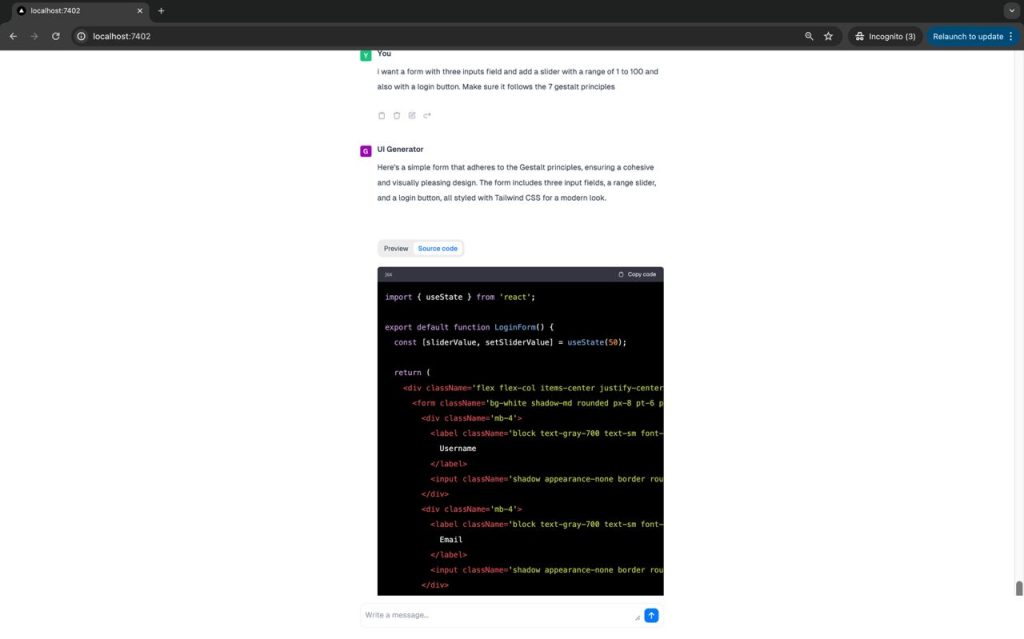
As part of the integrated technologies to enhance functionality and performance in the AI Prompt-UI Generator project, Qdrant plays a crucial role in enhancing the capabilities of the GPT-4 model within the project by addressing its limitation in performing efficient vector similarity searches based on embeddings. While GPT-4 excels in generating and understanding natural language text, the challenge lies in processing large datasets and retrieving contextually relevant information swiftly. To overcome this, the database segments data into manageable chunks, each containing a reasonable number of tokens. When users provide new text, algorithms like Euclidean distance, k-nearest neighbors, or inner-product convert the text into vectors for similarity search. Qdrant then efficiently identifies the closest chunks, enabling quick access to relevant data without needing to search through the entire dataset. This integration significantly enhances tasks such as semantic search, content recommendation, and clustering, ensuring that the AI Prompt-UI Generator delivers precise and contextually relevant responses to user inputs, thereby boosting overall functionality and performance.
Despite the GPT 4 model’s understanding of the project’s UI frameworks and other integrated technologies, integrating custom layers is essential due to the project’s diverse information requirements not fully covered by GPT-4. Custom layer integration is particularly valuable for storing specific project details, such as its nature, creator’s name, creation date, and more. This additional data, retrieved from a text file and sent along with each request, provides supplementary information that enriches the context of interactions beyond what GPT 4 can manage independently.
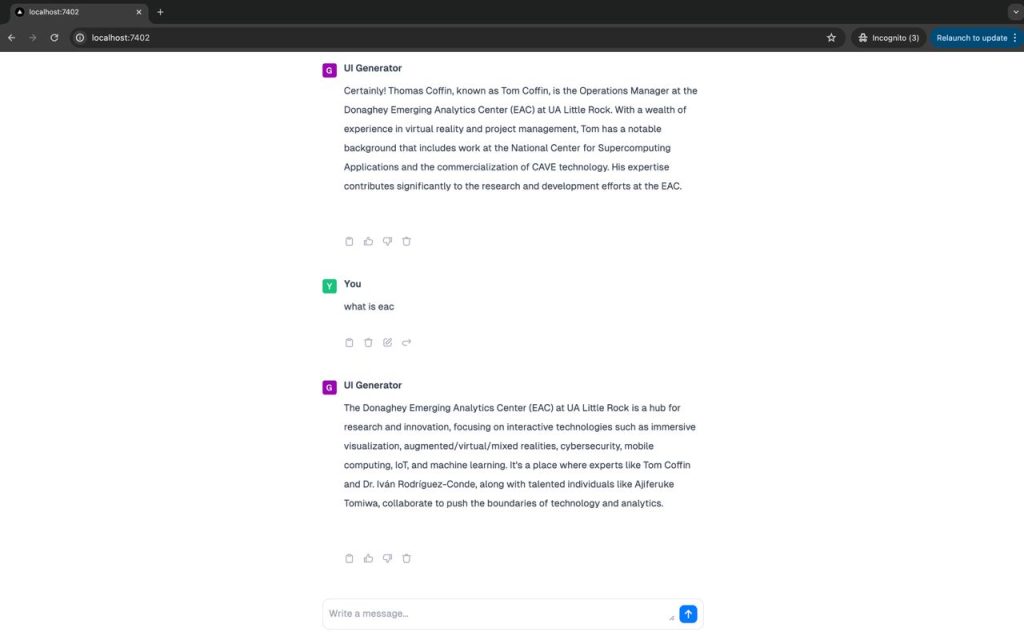
GPT-4, a state-of-the-art language model, operates on a stateless basis, meaning it does not retain memory of past interactions (Xiong et al., 2023). This presents a challenge for applications requiring context continuity across multiple sessions. The model’s ability to understand and generate responses is constrained by a token limit, which, in our implementation, is set to 4096 tokens. To overcome this limitation, we integrated a PostgreSQL database to manage and maintain conversation history. This external memory system stores user interactions, allowing for the retrieval of relevant context to be included in new prompts, thereby ensuring that the model can generate contextually accurate responses even when the conversation spans multiple sessions.
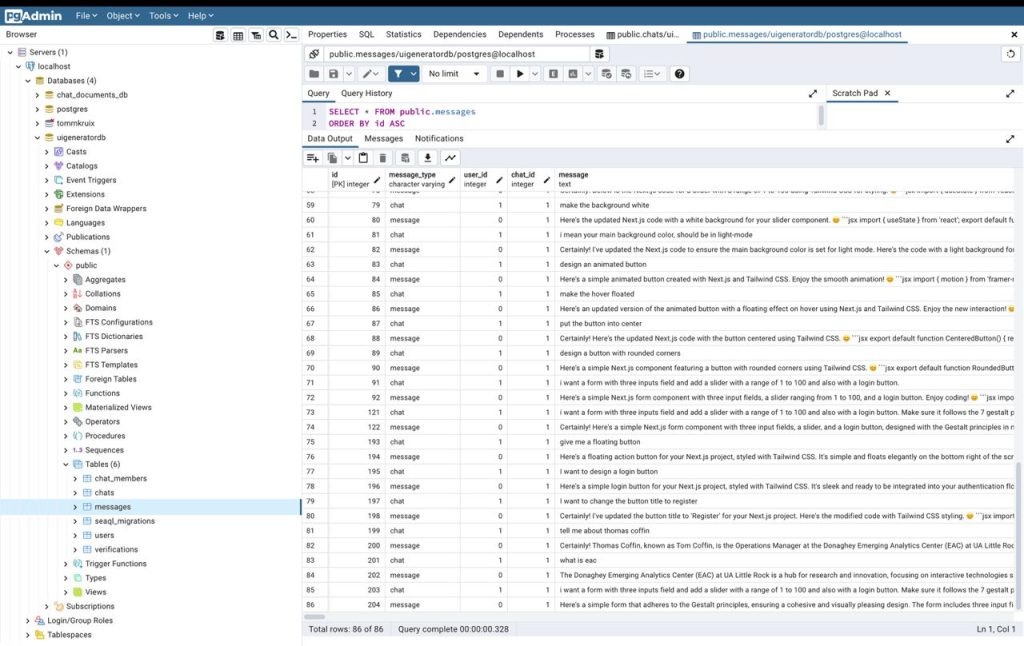
The process begins with storing each user’s conversation history in the PostgreSQL database, effectively creating an extended memory for the model. When a new user input is received, the system fetches the necessary context from the database, combining it with the new input to form a comprehensive prompt. This prompt is then processed by GPT-4 within the 4096-token limit, ensuring that all relevant information is considered. After generating a response, the context is updated in the database, including the latest interaction. This continuous updating mechanism allows the system to maintain coherence and relevance over long-term interactions, effectively addressing GPT-4’s stateless nature and enhancing user experience by providing a seamless conversational flow.
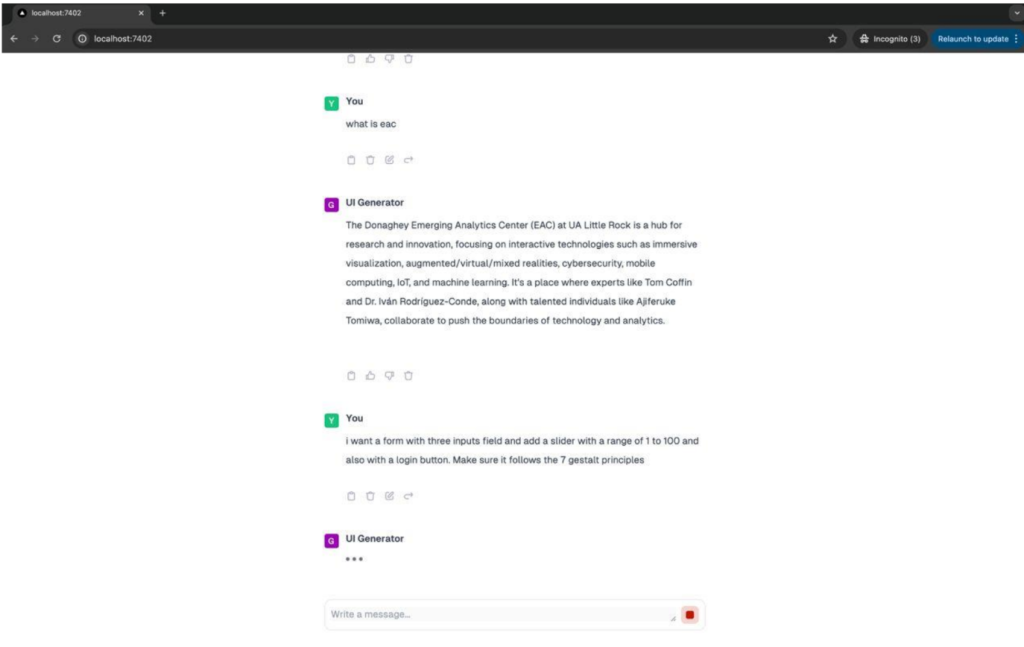
The AI Prompt-UI Generator is designed to revolutionize various real-world scenarios with its practical applications. For instance, a small business owner with minimal coding knowledge can effortlessly create a custom e-commerce website by simply describing the desired layout and features in plain language. The AI interprets prompts like “Create a product page with a grid layout, each product card showing an image, title, price, and ‘Add to Cart’ button” and generates the corresponding UI elements, complete with responsive design using Next.js and Tailwind CSS, as shown in the image below.

Another use case involves a UX designer prototyping a new mobile app interface. By providing prompts such as “Design a user profile screen with a profile picture, username, bio, and list of recent activities,” the designer receives a functional prototype ready for user testing, drastically reducing the time and effort typically required. Additionally, a software developer working on a dashboard for data visualization can request specific components like “Generate a dashboard with a sidebar, top navigation bar, and three chart sections for displaying sales, traffic, and user engagement data,” and the AI generates the required code in Rust for the backend, ensuring high performance. These examples demonstrate how the AI Prompt-UI Generator simplifies the creation of sophisticated, user-centric interfaces, making it an invaluable tool for various industries and applications.
In conclusion, the AI Prompt-UI Generator project represents a significant leap forward in user interface development, merging advanced natural language processing with cutting-edge AI technologies to democratize the creation of sophisticated digital interfaces. By enabling users to generate high-quality, personalized UIs through simple textual prompts, the project eliminates barriers for those with limited coding expertise, fostering inclusivity and creativity. The integration of powerful frameworks like Next.js, Tailwind CSS, and the high-performance Rust language ensures that these interfaces are not only visually appealing but also efficient and reliable. The use of Qdrant for enhanced vector similarity search and a PostgreSQL database for maintaining context continuity further refines the user experience, making interactions more accurate and seamless. Real world use cases, from e-commerce sites to mobile app prototypes and data visualization dashboards, highlight the practical value and versatility of the AI Prompt-UI Generator.
Ultimately, this project stands as a testament to the transformative potential of AI in UI development, offering immense benefits to developers, designers, and businesses by streamlining processes, reducing effort, and maximizing usability. This work-in-progress EAC project, stand as a testament of UA Little Rock’s commitment to advancing knowledge and exploring new frontiers in technology. At EAC, we believe that everyone deserves the power to shape the digital world, and this project is a testament to that mission.
[1] Cloudflare. (2024). What are LLMs used for? In Topics: What is a large language model (LLM)? Retrieved July 11, 2024, from https://www.cloudflare.com/learning/ai/what-is-large-language-model/
[2] Cronin, I. (2024). Understanding generative AI business applications: A guide to technical principles and real-world applications (1st ed.). Apress Berkeley, CA. https://doi.org/10.1007/979-8-8688-0282-9
[3] Holdsworth, J. (2024). What is NLP (natural language processing)? In What is natural language processing? IBM. Retrieved July 7, 2024, from https://www.ibm.com/topics/natural-language-processing
[4] Indeed Editorial Team. (2022). What is user interface (UI)? Career Guide. Retrieved July 7, 2024, from https://www.indeed.com/career-advice/career-development/user-interface
[5] Jitnupong, B., & Jirachiefpattana, W. (2018). Information system user interface design in software services organization: a small-clan case study. In MATEC Web of Conferences (Vol. 164, p.01006). EDP Sciences. https://doi.org/10.1051/matecconf/201816401006
[6] Marcus, A. (2002). Dare we define user-interface design? Interactions, 9(5), 19-24. https://doi.org/10.1145/566981.566992
[7] OpenAI. (2023). ChatGPT (Mar 14 version). Large language model. https://chat.openai.com/chat
[8] Raiaan, M. A. K., Mukta, M. S. H., Fatema, K., Fahad, N. M., Sakib, S., Mim, M. M. J., … & Azam, S. (2024). A review on large language models: Architectures, applications, taxonomies, open issues and challenges. IEEE Access. https://doi.org/10.1109/access.2024.3365742
[9] Strobelt, H., Webson, A., Sanh, V., Hoover, B., Beyer, J., Pfister, H., & Rush, A. M. (2022). Interactive and visual prompt engineering for ad-hoc task adaptation with large language models. IEEE transactions on visualization and computer graphics, 29(1), 1146-1156. https://doi.org/10.1109/tvcg.2022.3209479
[10] Xiong, H., Bian, J., Yang, S., Zhang, X., Kong, L., & Zhang, D. (2023). Natural language based context modeling and reasoning with llms: A tutorial. arXiv preprint arXiv:2309.15074.
Share this:
References and Paper attached here:
